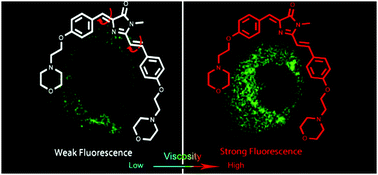A new GFP fluorophore-based probe for lysosome labelling and tracing lysosomal viscosity in live cells†
Abstract
Lysosomes, the main digestive compartment of live cells, are the most acidic organelles (pH 3.8–6.6) with the highest viscosity (47–190 cP at 25 °C). Lysosomal viscosity can reflect the status and function of the lysosomes, and abnormal lysosomal viscosity is responsible for the dysfunction of lysosomes, which is closely related to multiple diseases. In this work, a new GFP (green fluorescent protein) fluorophore-based probe (Lys-V) was designed and synthesized for mapping lysosomal viscosity in live cells. The increasing viscosity can restrict the two C![[double bond, length as m-dash]](https://www.rsc.org/images/entities/char_e001.gif) C twisting double bonds between phenol and imidazolidinone, causing the fluorescence emission of Lys-V to enhance with increasing viscosity, and there is an excellent linear relationship between log FI (515 nm) and log viscosity. Notably, fluorescence of Lys-V is quite stable in different pH solvents at the same viscosity, demonstrating that Lys-V is suitable for quantifying viscosity over a wide pH range (from 4 to 10). Because of its ideal water solubility, low cytotoxicity and weak basic amino morpholine substituents, Lys-V can be utilized for lysosome labelling in live cells. Significantly, the dynamic viscosity changes in lysosomes under dexamethasone stimulus could also be captured by Lys-V. Our results will allow Lys-V to become a new chemical tool for detecting lysosomal viscosity in live cells as well as unveiling the underlying mechanism of lysosome behaviour during various biological processes, which is beneficial for studying lysosome-related diseases as well as the exploration of lysosome-related pharmacology.
C twisting double bonds between phenol and imidazolidinone, causing the fluorescence emission of Lys-V to enhance with increasing viscosity, and there is an excellent linear relationship between log FI (515 nm) and log viscosity. Notably, fluorescence of Lys-V is quite stable in different pH solvents at the same viscosity, demonstrating that Lys-V is suitable for quantifying viscosity over a wide pH range (from 4 to 10). Because of its ideal water solubility, low cytotoxicity and weak basic amino morpholine substituents, Lys-V can be utilized for lysosome labelling in live cells. Significantly, the dynamic viscosity changes in lysosomes under dexamethasone stimulus could also be captured by Lys-V. Our results will allow Lys-V to become a new chemical tool for detecting lysosomal viscosity in live cells as well as unveiling the underlying mechanism of lysosome behaviour during various biological processes, which is beneficial for studying lysosome-related diseases as well as the exploration of lysosome-related pharmacology.



 Please wait while we load your content...
Please wait while we load your content...